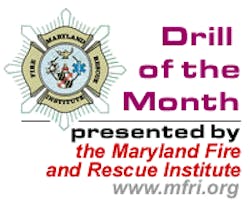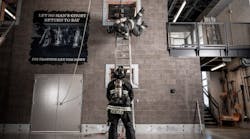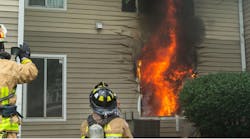Rescue Refresher
Session Reference: 1
Topic: Ropes, Knots, and Rigging
Time Required: Three Hours
Materials: 25 foot length of rope for each student webbing, harnesses, carabiners, figure eights ascenders, pulleys, prussic cords, slings blocks, rope
References:
• Rescue Technician, Mosby, Sessions 2-5
• Fire Service Rescue, Sixth Edition, IFSTA
PREPARATION
Motivation:
Objective (SPO): 1-1
The student will demonstrate a basic understanding of rope and rope hardware and software; tying of basic knots, and the use of various
rope accessories to construct mechanical advantage systems through participation in class discussions and practical activities.
Overview:
Ropes, Knots, and Rigging
• Demonstrate knowledge of rope types and strengths
• Demonstrate tying basic knots
• Demonstrate knowledge of rope software and hardware
• Demonstrate knowledge of anchoring points and use
• Demonstrate reeving blocks
• Demonstrate constructing mechanical advantage systems
SPO 1-1 The student will demonstrate a basic understanding of rope and rope hardware and software; tying of basic knots, and the use of various rope accessories to construct mechanical advantage systems through participation in class discussions and practical activities.
EO 1-1-1 Demonstrate a knowledge of rope used in rescue and the strength of the various sizes of lifeline.
EO 1-1-2 Demonstrate the tying of basic knots used in rescue.
EO 1-1-3 Demonstrate a knowledge of software and hardware used with rope in rescue.
EO 1-1-4 Demonstrate a knowledge of anchoring points and the various means of securing to them.
EO 1-1-5 Demonstrate reeving various types of blocks used in rescue to create mechanical advantage systems.
EO 1-1-6 Demonstrate constructing mechanical advantage systems such as the Z-rig and Piggyback Z-rig.
I . Rope Used In Rescue (1-1-1)
A. Lifeline Rope
1. Static kernmantle
2. Dynamic kernmantle
B. Utility rope
1. Synthetic fiber
a. Nylon
b. Polypropylene
c. Polyethylene
d. Kevlar
2. Natural fiber
a. Manila
b. Sisal
c. Cotton
C. Rope strength for lifeline rope
1. Tensile or breaking strength
a. 7/16-inch - 6,000 lbs.
b. 1/2-inch - 9,000 lbs.
c. 5/8-in. - 13,000 lbs.
2. Working strength
a. Tensile strength divided by 15
3. NFPA rope classification
a. Class One - one person life safety rope with greater than 300 lbs. working strength
b. Class Two - two person life safety rope with greater than 600 lbs. working strength
c. Life safety ropes must have internal tracer tape indicating compliance
II. Basic Rescue Knots (1-1-2)
A. Overhand Knot
1. Used as safety knot with other knots
2. Review how tied while students observe
B. Water Knot
1. Used to join two ends of webbing together
2. Review how tied while students observe
C. Bowline
1. Used as rescue knot or for hoisting tools
2. Review how tied while students observe
D. Clove Hitch
1. Used for securing a rope to an object
2. Review how tied while students observe
a. Clove hitch around object
b. Clove hitch over object
c. Split clove hitch
E. Figure Eight Knots
1. Used as stopper knot at end of rope (figure eight), form a fixed loop around an object (figure eight
on a bight or figure eight reweave), or join two ropes together (figure eight bend)
2. Review how tied while students observe
a. Figure eight
b. Figure eight on a bight
c. Figure eight reweave
d. Figure eight bend
III. Associated Software and Hardware ( 1 - 1 - 3 )
A. Webbing
1. Flat or tubular
2. Used in place of or with rope
3. Strength
a. 1-inch - 4,500 lbs. tensile strength
b. 2-inch - 6,000 lbs. tensile strength
B. Harnesses
1. Constructed of sewn webbing
2. Worn by rescuers during certain rescues
3. Types
a. NFPA/ANSI Class I - seat-style for emergency escape
b. NFPA Class II/ANSI Class IV - seat-style for rescue
c. NFPA/ANSI Class III – full body
d. ANSI Class IV - sit
NOTE: Only full body harnesses should be used when there is any likelihood that the rescuer will be turned upside down.
C. Carabiners
1. Constructed of steel or aluminum
2. Used for connecting rope or webbing to objects or other pieces of rope or webbing
3. Types
a. Steel - 6,700 lbs. tensile strength
b. Aluminum - 5,500 lbs. tensile strength
D. Figure Eights
1. Constructed of aluminum
2. Used for descent control or equipment collection (attaching several carabiners)
3. 20,000 lbs. tensile strength
E. Ascenders
1. Constructed of aluminum
2. Used for descent control or as part of a mechanical advantage system
3. 2,500 lbs. tensile strength
NOTE: Caution students that most manufacturers do not allow ascenders to be used in systems over 1,000 lbs.
F. Pulleys
1. Constructed of aluminum
2. Used as part of a mechanical advantage system or to change direction of pull
G. Blocks
1. Constructed with shells of wood or steel
2. Used as part of a mechanical advantage system or to change direction of pull
3. May be single or multiple sheave
H. Prussic Cords
1. Formed using 7/16-inch kernmantle rope
2. End connected together using double fisherman knot
3. Used in place of ascenders to control descent or as part of a mechanical advantage system
I . Slings
1. Formed from nylon webbing with end generally sewn to form eyes
2. Used to secure rope to anchor point or object being moved
IV. Anchor Points (1-1-4)
A. Selection of anchor points
1. Fixed objects
2. Building components
3. Apparatus (sturdy components)
4. Picket systems
B. Anchoring to objects
1. Single point
2. Tensionless
3. Multiple points
NOTE: Instructor should review each method of anchoring.
V. Reeving Blocks (1-1-5)
A. Used with rope to form block and tackle
B. Use proper size block for rope being used
C. Review reeving each type
1. Two over two
2. Three over three
3. Two over three
D. Snatch block used for change of direction
VI. Other Mechanical Advantage Systems (1-1-6)
A. Used in place of or with block and tackle
B. Requires less rope
C. Review constructing each type
1. Z-Rig
2. Piggy-back Z-rig
VII. Practical Exercise To Evaluate Skills Proficiency
A. Set up three practical skills stations with an evaluator at each station to observe skills proficiency. Divide the class evenly into three groups. Allow no more than thirty minutes for each group at each station.
B. Station 1 - Knots and anchoring to objects
1. Have each student tie the following knots with safety knot
a. Water knot
b. Bowline
c. Clove Hitch
1 ) Clove Hitch around an object
2 ) Clove hitch over an object
3 ) Split clove hitch
d. Figure Eight family
1 ) Figure Eight
2 ) Figure Eight on a bight
3 ) Figure Eight reweave
4 ) Figure Eight bend
2. Have each student demonstrate the following methods of anchoring to an object
a. Single point with rope and webbing
b. Tensionless with rope
c. Multiple points
NOTE: The knot tying and anchoring can be done in conjunction with one a n o t h e r.
C. Station 2 - Reeving blocks
1. Divide the students into pair and have each pair of students demonstrate reeving each of the
following block combinations
a. Two over two
b. Three over three
c. Two over three
2. Have the students demonstrate securing a snatch block to a fixed object and passing a rope
through it
D. Station 3 - Constructing other mechanical advantage systems
1. Divide the students into groups of no more than three and have each group demonstrate reeving
each of the following using both prussic cords and ascenders
a. Simple Z-rig
b. Piggyback Z-rig
2. Have the students demonstrate using the Z-rig to move an object
NOTE: All students are expected to perform all the practical skills to the satisfaction of the evaluators. Assistance should be provided when required.
SUMMARY
Student Performance Objective:
The student will demonstrate a basic understanding of rope and rope hardware and software; tying of basic knots, and the use of various rope accessories to construct mechanical advantage systems through participation in class discussions and practical activities.
Review:
Ropes, Knots, and Rigging
• Demonstrate knowledge of rope types and strengths
• Demonstrate tying basic knots
• Demonstrate knowledge of rope software and hardware
• Demonstrate knowledge of anchoring points and use
• Demonstrate reeving blocks
• Demonstrate constructing mechanical advantage systems
Evaluation:
All students are expected to perform all the practical skills to the satisfaction of the evaluators. Assistance should be provided when required.






